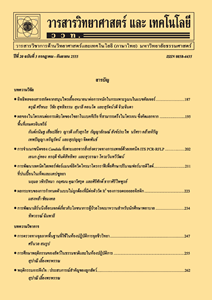การประยุกต์ภูมิสารสนเทศเพื่อการประเมินคุณภาพอากาศในพื้นที่กรุงเทพมหานคร
Main Article Content
Abstract
The purposes of this research were (1) to analyze the concentration of air pollutants distributed in Bangkok area. According to the statistics, gathered by interpolation method of air quality measurement in Bangkok area and conducted by Air Quality and Sound Management Office Pollution Control Department in 2017, the concentration rates of all six-air pollutant distribution were exceeded the air quality standard. The air polluted substance with the highest concentration was dust particles less than 10 microns (PM10). The second highest pollutant concentration was nitrogen dioxide (NO2), following by ozone (O3), dust particles less than 2.5 microns (PM2.5), sulfur dioxide (SO2) and carbon monoxide (CO), respectively. (2) To analyze factors affecting the distribution of air pollutants. The first source of air pollutant was industrial factory emission. By researching the concentration of 8,546 industrial factories in Bangkok, it was concluded that the high concentration areas are located in southwest, middle, and south of Bangkok, with 30 areas in total. Furthermore, the significant industrial factory substances caused air pollution the most were ozone (O3), dust particles less than 10 microns (PM10), carbon monoxide (CO), dust particles less than 2.5 microns (PM2.5), sulfur dioxide (SO2), and nitrogen dioxide (NO2). Another significant source of air pollutant was from traffic. 13 Heavy traffic routes in Bangkok were used to analyze the correlation of air pollutions during the specific time in Bangkok area. The result revealed that there are 5 areas with extremely heavy traffic jam, which are mostly located in the city center followed by the area in the eastern part of the city. By this, the substances from the traffic that caused air pollution the most were carbon monoxide (CO), dust particles less than 10 microns (PM10), ozone (O3), dust particles less than 2.5 microns (PM2.5), nitrogen dioxide (NO2), and sulfur dioxide (SO2), respectively. The durations with the highest pollution were 4 am to 8 am and 4 pm to 8 pm, since they were the rush hours for people to go to work and to go back to their residences that, consequently, caused heavy traffic. Specifically, the carbon dioxide (CO2) caused by vehicles. The result of analyzing the surveillance areas of air pollution in Bangkok in 2017 claimed that there are 47 areas needed to be inspected, mostly located in Don Mueng, Lak-sii, Lao-prao, Chatuchak, and the areas in the southwest, the south, and the center of Bangkok. The most significant factor which affected air pollution was traffic pollutants and the second most was industrial factory emission.
Article Details
References
[2] Pollution Control Department Bangkok Thailand, Air Pollution and Noise Over Standard in Bangkok, Available Source: https://www.facebook.com/PCD.go.th/posts/1601714289911952, March 2, 2018. (in Thai)
[3] Health Department Bangkok Metropolitan Administration, Air Pollution, Available Source: https://web.ku.ac.th/schoolnet/snet6/envi3/monpit-a/monpit-a.htm, February 24, 2018. (in Thai)
[4] BMA Data Center, Bangkok Present, Available Source: https://203.155.220.230/m.info/nowbma, February 24, 2018. (in Thai)
[5] Thairath Online, 2018, Hourly Traffic, Available Source: https://www.thairath.co.th/content/871172, March 2, 2018. (in Thai)
[6] Intarat, T., 2011, Geoinformatics Application on Air Quality Assessment: A Case Study in Chonburi Province, Faculty of Geoinformatics, Burapha University, Chonburi.
[7] Chaiyakarm, T. and Jirakajohnkool, S., 2013, Geographic Information Systems Application for Volatile Organic Compounds (VOCs) Risk Zone Analysis, in Rayong Province, Thai J. Sci. Technol. 3(3): 160-172.
[8] Inthanil, T. and Intarat, T., 2011, Air quality assessment in Nonthaburi province in year 2005-2009, NU Sci. J. 7(1): 59-70.
[9] Thailand Development Research Institute, 2002, Air Quality, Available Source: https://www.thaienvimonitor.net/Concept/priority5.htm, February 20, 2018. (in Thai)
[10] Jirakajohnkool, S., 2017, Learn Geo-Informatics System with Program ArcGIS Desktop 10.5 for Desktop, A.P. Graphic Design and Printing, Co. Ltd., Bangkok. (in Thai)
[11] Pollution Control Department, Situation and Management of Air and Noise Pollution Problems in Year 2012, Available Source: https://www.pcd.go.th/public/Publications/print_report.cfm?task=air_noise55, March 2, 2018. (in Thai)
[12] Seinfeld, J.H., 1986, Atmospheric Chemistry and Physics of Air Pollution, John Wiley & Sons, New York.


